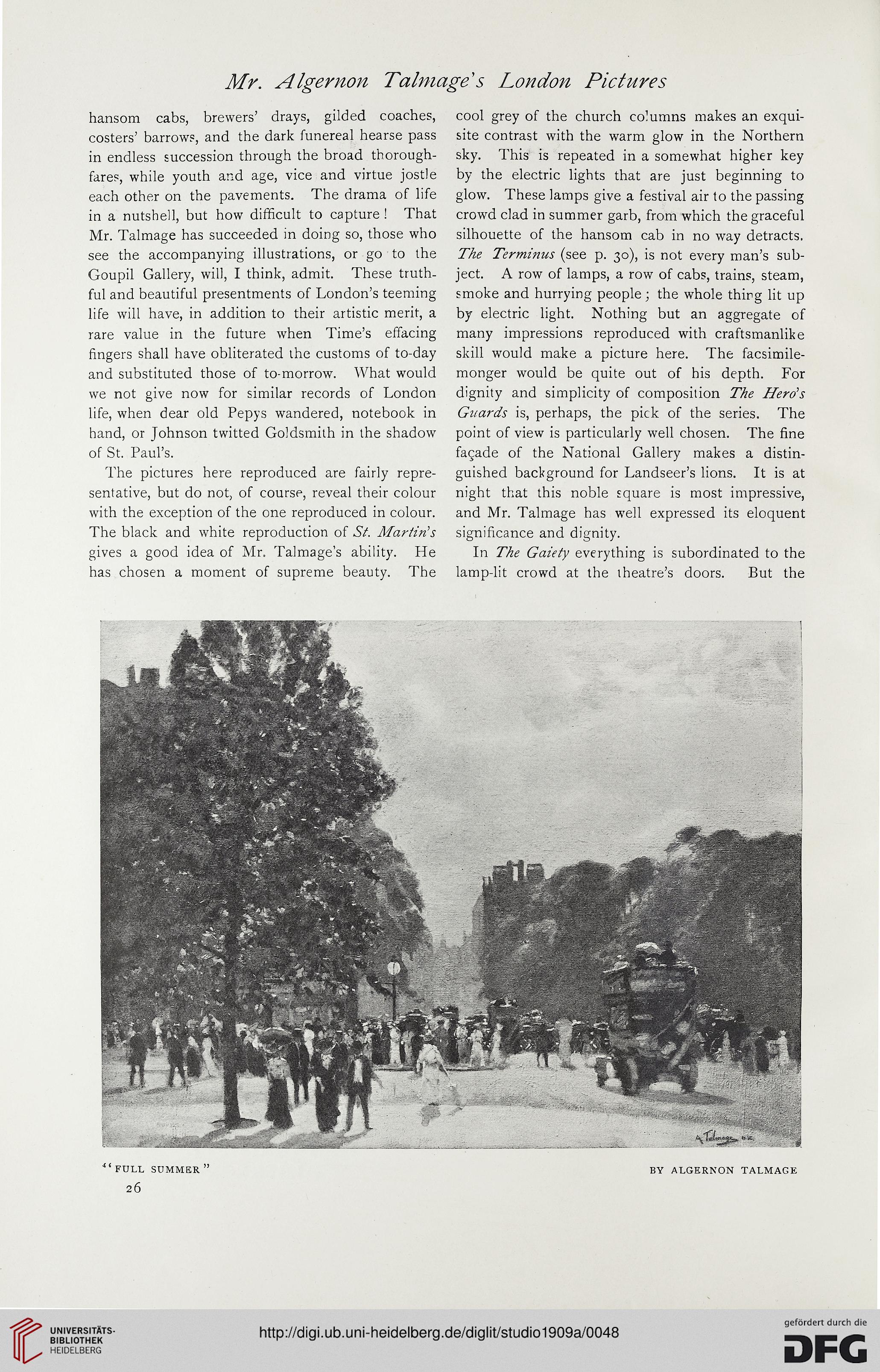Mr. Algernon Talmages London Pictures
hansom cabs, brewers’ drays, gilded coaches,
costers’ barrows, and the dark funereal hearse pass
in endless succession through the broad thorough-
fares, while youth and age, vice and virtue jostle
each other on the pavements. The drama of life
in a nutshell, but how difficult to capture ! That
Mr. Talmage has succeeded in doing so, those who
see the accompanying illustrations, or go to the
Goupil Gallery, will, I think, admit. These truth-
ful and beautiful presentments of London’s teeming
life will have, in addition to their artistic merit, a
rare value in the future when Time’s effacing
fingers shall have obliterated the customs of to-day
and substituted those of to-morrow. What would
we not give now for similar records of London
life, when dear old Pepys wandered, notebook in
hand, or Johnson twitted Goldsmith in the shadow
of St. Paul’s.
The pictures here reproduced are fairly repre-
sentative, but do not, of course, reveal their colour
with the exception of the one reproduced in colour.
The black and white reproduction of St. Martin's
gives a good idea of Mr. Talmage’s ability. He
has chosen a moment of supreme beauty. The
cool grey of the church columns makes an exqui-
site contrast with the warm glow in the Northern
sky. This is repeated in a somewhat higher key
by the electric lights that are just beginning to
glow. These lamps give a festival air to the passing
crowd clad in summer garb, from which the graceful
silhouette of the hansom cab in no way detracts.
The Terminus (see p. 30), is not every man’s sub-
ject. A row of lamps, a row of cabs, trains, steam,
smoke and hurrying people; the whole thirg lit up
by electric light. Nothing but an aggregate of
many impressions reproduced with craftsmanlike
skill would make a picture here. The facsimile-
monger would be quite out of his depth. For
dignity and simplicity of composition The Hero's
Guards is, perhaps, the pick of the series. The
point of view is particularly well chosen. The fine
fapade of the National Gallery makes a distin-
guished background for Landseer’s lions. It is at
night that this noble square is most impressive,
and Mr. Talmage has well expressed its eloquent
significance and dignity.
In The Gaiety everything is subordinated to the
lamp-lit crowd at the theatre’s doors. But the
hansom cabs, brewers’ drays, gilded coaches,
costers’ barrows, and the dark funereal hearse pass
in endless succession through the broad thorough-
fares, while youth and age, vice and virtue jostle
each other on the pavements. The drama of life
in a nutshell, but how difficult to capture ! That
Mr. Talmage has succeeded in doing so, those who
see the accompanying illustrations, or go to the
Goupil Gallery, will, I think, admit. These truth-
ful and beautiful presentments of London’s teeming
life will have, in addition to their artistic merit, a
rare value in the future when Time’s effacing
fingers shall have obliterated the customs of to-day
and substituted those of to-morrow. What would
we not give now for similar records of London
life, when dear old Pepys wandered, notebook in
hand, or Johnson twitted Goldsmith in the shadow
of St. Paul’s.
The pictures here reproduced are fairly repre-
sentative, but do not, of course, reveal their colour
with the exception of the one reproduced in colour.
The black and white reproduction of St. Martin's
gives a good idea of Mr. Talmage’s ability. He
has chosen a moment of supreme beauty. The
cool grey of the church columns makes an exqui-
site contrast with the warm glow in the Northern
sky. This is repeated in a somewhat higher key
by the electric lights that are just beginning to
glow. These lamps give a festival air to the passing
crowd clad in summer garb, from which the graceful
silhouette of the hansom cab in no way detracts.
The Terminus (see p. 30), is not every man’s sub-
ject. A row of lamps, a row of cabs, trains, steam,
smoke and hurrying people; the whole thirg lit up
by electric light. Nothing but an aggregate of
many impressions reproduced with craftsmanlike
skill would make a picture here. The facsimile-
monger would be quite out of his depth. For
dignity and simplicity of composition The Hero's
Guards is, perhaps, the pick of the series. The
point of view is particularly well chosen. The fine
fapade of the National Gallery makes a distin-
guished background for Landseer’s lions. It is at
night that this noble square is most impressive,
and Mr. Talmage has well expressed its eloquent
significance and dignity.
In The Gaiety everything is subordinated to the
lamp-lit crowd at the theatre’s doors. But the




